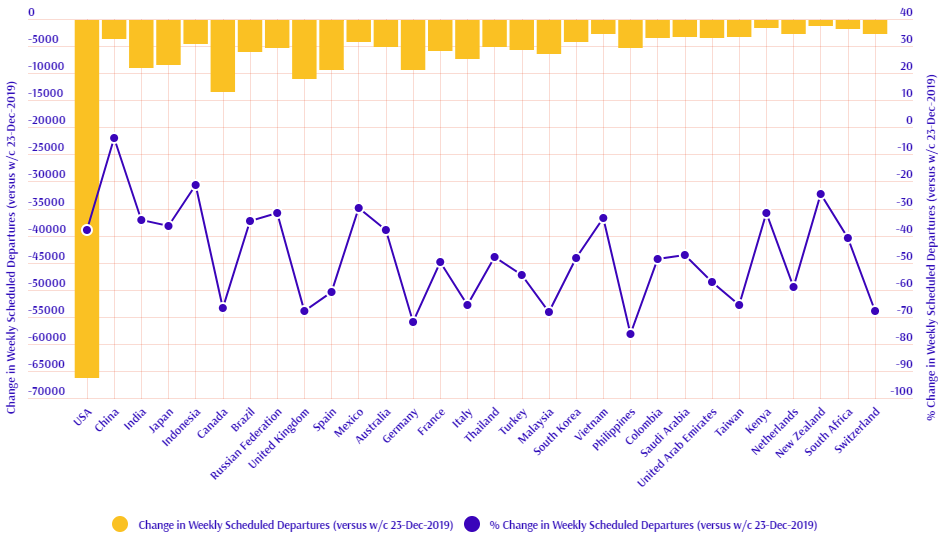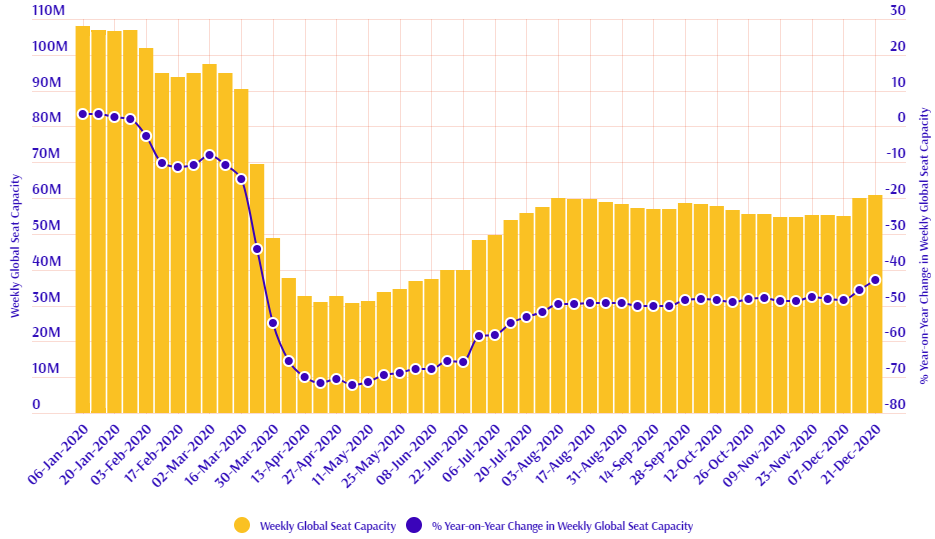Right now, as the COVID storm clouds again gather and highly transmissible mutated versions of the coronavirus spread, there is a need for some positivity, especially at this normally joyous time of the year where we will feel its effects more than ever. Missing friends and family will be hard, but a small price to pay to minimise the spread of a virus that has now infected approaching 80 million across the globe and killed over 1.7 million.
The final full week of 2020 provides the perfect gift and continues a seasonal rise in flight frequencies that sees a second successive increase. CTC - Corporate Travel Community analysis of OAG schedule data for the week commencing 21-Dec-2020 sees global flight frequencies rising +0.9% with the addition of over 3,800 departures when compared to last week.
Total global weekly departures in the analysis week exceed 421,000 to hit a new weekly high since levels fell back in Mar-2020. The levels may be down significantly on where they would normally be at this time of the year, but represent a +84.3% rise from the lows of May-2020.
There are again rises in almost all regions of the world, but the regions were the latest virus mutations have been centred - Southern Africa (-11.1%) and Western Europe (-3.0%) - head the markets where flight levels are down on last week, however in Western Europe's case that is a following a week where flight flights rose by a third (+33.5%).
South America is the only other areas to see a week-on-week fall in flights, down -3.0% in its lower region and -0.1% in its upper region. North America again sees the largest rise in flight volumes, up 2,250, a +2.0% rise, while Central and Eastern Europe (+7.4%) and North Africa (+7.1%) see the largest percentage rises versus last week's levels.

At a country level there is very little movement among the world's top 20 largest markets by departures. In fact, Thailand and France trading placed between #12 and #13 and Germany and Italy between #18 and #19 are the only changes this week. The Russian Federation sees weekly departures rise back above 10,000 delivering the largest growth (+10.9%) among the top 10 markets, a percentage figure only beaten by France (+14.9%) and Ethiopia (+30.3%) across the top 50 markets.
The Russian Federation is joined in growth among the top ten by Indonesia (+3.9%), India (+3.6%), Japan (+3.0%), USA (+2.8%), Mexico (+2.0%) and Australia (+1.9%). Brazil (-3.6%), China (-0.5%) and Canada (-6.9%) all see week-on-week declines.
Egypt (+10.5%), Tunisia (+25.6%), Lithuania (+13.3%) and Macau (+17.7%) are among the many markets with double-digit week-on-week growth. Norway (-24.6%), Sweden (-18.1%), Denmark (-21.4%), Austria (-17.1%), Finland (-13.8%), Zambia (-25.7%), Croatia (-18.1%), Iceland (-21.5%), Greenland (-58.9%), Hungary (-15.5%) are among the largest markets to see double-digit week-on-week declines.
Myanmar continues a topsy-turvy trend: after departures doubled (+101.7%), then reduced by half (-53.8%), then rose more than three quarters (88.8%), have now fallen again by more than a quarter (-28.7%).

This week's +0.9% increase in flights and +1.8% rise in capacity means that the year-on-year performance takes another big improvement step. This week, flight frequencies are down 'just' -40.5%, a +3.0 percentage point improvement on last week, better than last week's +2.6 percentage points gain. Capacity levels are down -42.9%, a +2.7% percentage point rise.
The numbers this week are certainly a positive present for the industry. Next week's data takes us into 2021 where year-on-year metrics should be showing positives, even if levels will still be down on the baseline performance of 2019.